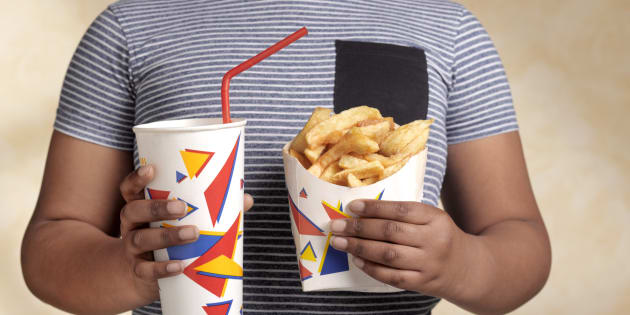
Recently, while strolling in an upscale Delhi mall with a friend, I spotted a young mother with a crying child. Then I overheard the flustered woman saying in Hindi, "Don't cry... I'll fetch you a burger right now." Soon, the kid was quiet, gobbling down a burger and swigging a cold drink. Oh, and I forgot to mention: the mother was obese. Such scenes are not uncommon in urban environments. We think nothing of it when we see toddlers and young children munching on chips or other junk food.
- The WHO estimates that as per the current trend, 70 million young children will be overweight or obese by 2025.
This year, I had the privilege of attending the 69th World Health Assembly in Geneva, where the World Health Organization (WHO) passed a momentous resolution on ending childhood obesity. The proposal, sponsored by the delegations of Australia, Canada, Colombia, Ecuador, Ghana, Malaysia, Mexico, Monaco, Thailand and Zambia, received overwhelming endorsement. It was indeed a historic moment for the world to take cognizance of the alarming trend in child obesity.
Childhood obesity is excessive fat accumulation in infants and children up to 19 years of age. The WHO estimates that as per the current trend, 70 million young children will be overweight or obese by 2025. One widely prevalent assumption is that obesity is a manifestation of affluence or than only rich people can be afflicted by it. This is wrong. The situation is actually worse in developing countries. India falls in this category.
The resolution includes a comprehensive set of recommendations to tackle childhood obesity, including: promoting intake of healthy foods and physical activity, integrating non-communicable disease guidelines with the pre-conception and antenatal programmes, providing support to inculcate healthy eating habits, implementing comprehensive programmes promoting healthy school environments, health and nutrition education and physical activity, and providing family-based counselling services for children and adolescents who are obese.
The most striking recommendation with respect to India involves promoting healthy school environments for which Maneka Gandhi, Union Minister for Women and Child Development, proposed a ban on sale of junk food in school canteens, as well as within a radius of 200 metres by private vendors and hawkers during school hours (7am-4pm). This move came after Uday Foundation, a non-government organization in India filed a Public Interest Litigation in 2011 seeking a ban on junk food and carbonated drinks in the schools and also for its sell within a radius of 500 yards. Finally, in 2015 the High Court ordered strict implementation of Food Safety and Standards Authority of India (FSSAI) guidelines for making available wholesome, nutritious, safe and hygienic food to schoolchildren in India.
- Any right-thinking Indian will concede that the need of the hour is to focus more on nutrition promotion and education.
The guidelines classify certain foods as high in fat and sugar (HFSS) -- such as chips, fried foods, carbonated beverages, ready-to-eat noodles, pizzas, burgers, potato fries, confectionery items, chocolates, candy, samosas, bread pakoras etc.). A circular was issued to all schools affiliated to the Central Board of Secondary Education in India in this regard, this year in January. It directed the schools to also constitute a canteen management committee with 7-10 members to decide the type of food to be prepared, ensure food safety, study infrastructural gaps in implementation, design physical activity programs, avail services of health experts, and develop awareness resource material pertaining to nutrition and health. In addition, it recommended the celebration of Nutrition Week, regular monitoring of body mass index, inspection of lunch boxes and doing community outreach programmes for the promotion of physical activity. The circular also suggested that parents "may be" involved by raising their awareness levels and that children be taught about a healthy lifestyle in the curriculum. Although the intent of the government is noble, it is the implementation of these guidelines that will determine their success.
Certain issues continue to remain fuzzy and need to be addressed:
• Lack of clarity on how to put these guidelines into action. A detailed strategy is required on what to do, how to do it, and who will do what. A time line and measurable indicators to monitor and evaluate implementation is also necessary.
• The terminology may pose problems in the Indian scenario. The guidelines classify chips in the HFSS category but what about aloo bhaji?
• With the country experiencing a rise in the number of international schools where children from different nationalities and ethnicities study, the guidelines fall short. For instance, it has noodles in the HFSS category but for some nationalities such as Japanese/Korean/Chinese, noodles are staple.
• The guidelines seem superficial in terms of not addressing healthy alternatives to the existing food items. They advise banning burgers, but what if a burger is made of a wholegrain bun and has a soy patty?
• Nothing is mentioned regarding the consequences of non-compliance with these guidelines by schools.
If we need to curb childhood obesity, we require concerted efforts from the government, schools, parents as well as children instead of working in silos.
Any right-thinking Indian will concede that the need of the hour is to focus more on nutrition promotion and education, which after all is the bedrock of such social change. Such an orientation included in the "may be" category appears misconceived. Leave alone children, not many parents are aware of the concepts of healthy or unhealthy eating. Even teachers may be lagging in such knowledge. The government needs to take a cue from the food and beverage industry on their marketing skills for these unhealthy foods and beverages directed at children. I don't think I have seen advertisements on choosing healthy foods, barring a couple on eggs and milk. If we need to curb childhood obesity, we require concerted efforts from the government, schools, parents as well as children instead of working in silos. Mere banning of junk food alone may not be the solution that we need.
No comments:
Post a Comment